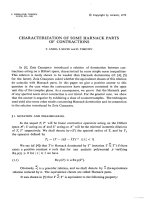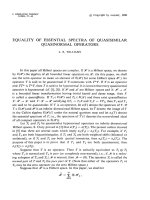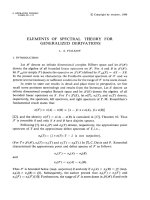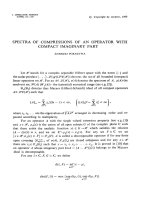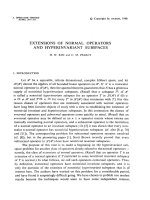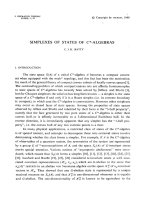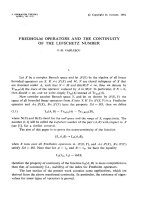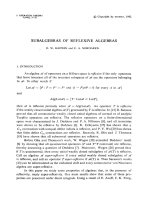Báo cáo toán học: "Kernels of Directed Graph Laplacians" potx
Bạn đang xem bản rút gọn của tài liệu. Xem và tải ngay bản đầy đủ của tài liệu tại đây (101.59 KB, 8 trang )
Kernels of Directed Graph Laplacians
J. S. Caughman and J. J. P. Veerman
Department of Mathematics and Statistics
Portland State University
PO Box 751, Portland, OR 97207.
,
Submitted: Oct 28, 2005; Accepted: Mar 14, 2006; Published: Apr 11, 2006
Mathematics Subject Classification: 05C50
Abstract. Let G denote a directed graph with adjacency matrix Q and in-
degree matrix D. We consider the Kirchhoff matrix L = D − Q, sometimes
referred to as the directed Laplacian. A classical result of Kirchhoff asserts that
when G is undirected, the multiplicity of the eigenvalue 0 equals the number
of connected components of G. This fact has a meaningful generalization to
directed graphs, as was observed by Chebotarev and Agaev in 2005. Since
this result has many important applications in the sciences, we offer an inde-
pendent and self-contained proof of their theorem, showing in this paper that
the algebraic and geometric multiplicities of 0 are equal, and that a graph-
theoretic property determines the dimension of this eigenspace – namely, the
number of reaches of the directed graph. We also extend their results by deriv-
ing a natural basis for the corresponding eigenspace. The results are proved in
the general context of stochastic matrices, and apply equally well to directed
graphs with non-negative edge weights.
Keywords: Kirchhoff matrix. Eigenvalues of Laplacians. Graphs. Stochastic matrix.
1 Definitions
Let G denote a directed graph with vertex set V = {1, 2, , N} and edge set E ⊆
V ×V .Toeachedgeuv ∈ E, we allow a positive weight ω
uv
to be assigned. The adjacency
matrix Q is the N × N matrix whose rows and columns are indexed by the vertices, and
where the ij-entry is ω
ji
if ji ∈ E and zero otherwise. The in-degree matrix D is the
N × N diagonal matrix whose ii-entry is the sum of the entries of the i
th
row of Q.The
matrix L = D − Q is sometimes referred to as the Kirchhoff matrix, and sometimes as
the directed graph Laplacian of G.
A variation on this matrix can be defined as follows. Let D
+
denote the pseudo-inverse
of D. In other words, let D
+
be the diagonal matrix whose ii-entry is D
−1
ii
if D
ii
=0
the electronic journal of combinatorics 13 (2006), #R39 1
and whose ii-entry is zero if D
ii
= 0. Then the matrix L = D
+
(D − Q) has nonnegative
diagonal entries, nonpositive off-diagonal entries, all entries between -1 and 1 (inclusive)
and all row sums equal to zero. Furthermore, the matrix S = I −Lis stochastic.
We shall see (in Section 4) that both L and L can be written in the form D − DS
where D is an appropriately chosen nonnegative diagonal matrix and S is stochastic. We
therefore turn our attention to the properties of these matrices for the statement of our
main results.
We show that for any such matrix M = D − DS, the geometric and algebraic multi-
plicities of the eigenvalue zero are equal, and we find a basis for this eigenspace (the kernel
of M). Furthermore, the dimension of this kernel and the form of these eigenvectors can
be described in graph theoretic terms as follows.
We associate with the matrix M a directed graph G,andwritej i if there exists
a directed path from vertex j to vertex i. For any vertex j, we define the reachable set
R(j) to be the set containing j and all vertices i such that j i. A maximal reachable
set will be called a reach. We prove that the algebraic and geometric multiplicity of 0 as
an eigenvalue for M equals the number of reaches of G.
We also describe a basis for the kernel of M as follows. Let R
1
, R
k
denote the reaches
of G. For each reach R
i
, we define the exclusive part of R
i
to be the set H
i
= R
i
\∪
j=i
R
j
.
Likewise, we define the common part of R
i
to be the set C
i
= R
i
\ H
i
. Then for each
reach R
i
there exists a vector v
i
in the kernel of M whose entries satisfy: (i) (v
i
)
j
= 1 for
all j ∈ H
i
; (ii) 0 < (v
i
)
j
< 1 for all j ∈ C
i
; (iii) (v
i
)
j
= 0 for all j ∈ R
i
. Taken together,
these vectors v
1
, v
2
, , v
k
form a basis for the kernel of M and sum to the all 1’s vector 1.
Due to the recent appearance of Agaev and Chebotarev’s notable paper [1], we would
like to clarify the connections to their results. In that paper, the matrices studied have
the form M = α(I − S)whereα is positive and S stochastic. A simple check verifies
that this is precisely the set of matrices of the form D − DS,whereD is nonnegative
diagonal. The number of reaches corresponds, in that paper, with the in-forest dimension.
And where that paper concentrates on the location of the Laplacian eigenvalues in the
complex plane, we instead have derived the form of the associated eigenvectors.
2 Stochastic matrices
Amatrixissaidtobe(row) stochastic if the entries are nonnegative and the row sums
all equal 1. Our first result is a special case of Gerˇsgorin’s theorem [3, p.344].
2.1 Lemma. Suppose S is stochastic. Then each eigenvalue λ satisfies |λ|≤1.
2.2 Definition. Given any real N × N matrix M,wedenotebyG
M
the directed
graph with vertices 1, , N andanedgej → i whenever M
ij
=0. For each vertex i,set
N
i
:= {j | j → i}. We write j i if there exists a directed path in G
M
from vertex j to
vertex i. Furthermore, for any vertex j, we define R(j) to be the set containing j and all
vertices i such that j i. We refer to R(j)asthereachable set of vertex j. Finally, we
say a matrix M is rooted if there exists a vertex r in G
M
such that R(r) contains every
vertex of G
M
. We refer to such a vertex r as a root.
the electronic journal of combinatorics 13 (2006), #R39 2
2.3 Lemma. Suppose S is stochastic and rooted. Then the eigenspace E
1
associated
with the eigenvalue 1 is spanned by the all-ones vector 1.
Proof. Conjugating S by an appropriate permutation matrix if necessary, we may assume
that vertex 1 is a root. Since S is stochastic, S1 = 1 so 1 ∈E
1
. By way of contradiction,
suppose dim(E
1
) > 1 and choose linearly independent vectors x, y ∈E
1
. Suppose |x
i
| is
maximized at i = n. Comparing the n-entry on each side of the equation x = Sx,wesee
that
|x
n
|≤
j∈N
n
S
nj
|x
j
|≤|x
n
|
j∈N
n
S
nj
= |x
n
|.
Therefore, equality holds throughout, and |x
j
| = |x
n
| for all j ∈N
n
. In fact, since
j∈N
n
S
nj
x
j
= x
n
, it follows that x
j
= x
n
for all j ∈N
n
.SinceS is rooted at vertex
1, a simple induction now shows that x
1
= x
n
.So|x
i
| is maximized at i =1. Thesame
argument applies to any vector in E
1
and so |y
i
| is maximized at i =1.
Since y
1
= 0 we can define a vector z such that z
i
:= x
i
−
x
1
y
1
y
i
for each i.This
vector z, as a linear combination of x and y,mustbelongtoE
1
. It follows that |z
i
| is also
maximized at i =1. Butz
1
= 0 by definition, so z
i
= 0 for all i. It follows that x and y
are not linearly independent, a contradiction.
2.4 Lemma. Suppose S is stochastic N × N and vertex 1 is a root. Further assume N
1
is empty. Let P denote the principal submatrix obtained by deleting the first row and
column of S. Then the spectral radius of P is strictly less than 1.
Proof. Since N
1
is empty, S is block lower-triangular with P as a diagonal block. So
the spectral radius of P cannot exceed that of S. Therefore, by Lemma 2.1, the spectral
radius of P is at most 1. By way of contradiction, suppose the spectral radius of P is equal
to 1. Then by the Perron-Frobenius theorem (see [3, p. 508]), we would have Px = x for
some nonzero vector x.
Define a vector v with v
1
=0andv
i
= x
i−1
for i ∈{2, , N}. We find that
Sv =
1
0 ···0
S
21
.
.
.
S
N1
P
0
x
=
0
x
= v.
So v ∈E
1
.Butv
1
= 0, so Lemma 2.3 implies x = 0. This contradiction completes the
proof.
2.5 Corollary. Suppose S is stochastic and N × N. Assume the vertices of G
S
can
be partitioned into nonempty sets A, B such that for every b ∈ B, there exists a ∈ A
with a b in G
S
. Then the spectral radius of the principal submatrix S
BB
obtained by
deleting from S therowsandcolumnsofA is strictly less than 1.
Proof. Define the matrix
ˆ
S by
ˆ
S =
1 0
u S
BB
,
the electronic journal of combinatorics 13 (2006), #R39 3
where u is chosen so that
ˆ
S is stochastic. We claim that
ˆ
S is rooted (at 1). To see this,
pick any b ∈ B. We must show 1 b in G
ˆ
S
. By hypothesis there exists a ∈ A with a b
in G
S
.Let
a = x
0
→ x
1
→···→x
n
= b
be a directed path in G
S
from a to b.Leti be maximal such that x
i
∈ A. Then the
x
i+1
,x
i
entry of S is nonzero, so the x
i+1
row of S
BB
has row sum strictly less than 1.
Therefore, the x
i+1
entry of the first column of
ˆ
S is nonzero. So 1 → x
i+1
in G
ˆ
S
and
therefore 1 b in G
ˆ
S
as desired. So
ˆ
S is rooted, and the previous lemma gives the result.
2.6 Definition. AsetR of vertices in a graph will be called a reach if it is a maximal
reachable set; in other words, R is a reach if R = R(i) for some i and there is no j such
that R(i) ⊂R(j) (properly). Since our graphs all have finite vertex sets, such maximal
sets exist and are uniquely determined by the graph. For each reach R
i
of a graph, we
define the exclusive part of R
i
to be the set H
i
= R
i
\∪
j=i
R
j
. Likewise, we define the
common part of R
i
to be the set C
i
= R
i
\ H
i
.
2.7 Theorem. Suppose S is stochastic N × N and let R denote a reach of G
S
with
exclusive part H and common part C. Then there exists an eigenvector v ∈E
1
whose
entries satisfy
(i) v
i
=1 for all i ∈ H,
(ii) 0 <v
i
< 1 for all i ∈ C,
(iii) 0 for all i ∈ R.
Proof. Let Y denote the set of vertices not in R. Permuting rows and columns of S if
necessary, we may write S as
S =
S
HH
S
HC
S
HY
S
CH
S
CC
S
CY
S
YH
S
YC
S
YY
=
S
HH
00
S
CH
S
CC
S
CY
00S
YY
Since S
HH
is a rooted stochastic matrix, it has eigenvalue 1 with geometric multiplicity
1. The associated eigenvector is 1
H
.
Observe that S
CC
has spectral radius < 1 by Corollary 2.5. Further, notice that
S(1
H
, 0
C
, 0
Y
)
T
=(1
H
,S
CH
1
H
, 0
Y
).
T
Using this, we find that solving the equation
S(1
H
, x, 0
C
)
T
=(1
H
, x, 0
C
)
T
for x amounts to solving
1
H
S
CH
1
H
+ S
CC
x
0
Y
=
1
H
x
0
Y
.
the electronic journal of combinatorics 13 (2006), #R39 4
Solving the above, however, is equivalent to solving (I − S
CC
)x = S
CH
1
H
. Since the
spectral radius of S
CC
is strictly less than 1, the eigenvalues of I − S
CC
cannot be 0. So
I − S
CC
is invertible. It follows that x =(I − S
CC
)
−1
S
CH
1
H
is the desired solution.
Conditions (i) and (iii) are clearly satisfied by (1
H
, x, 0
Y
),
T
so it remains only to verify
(ii). To see that the entries of x are positive, note that (I − S
CC
)
−1
=
∞
i=0
S
i
CC
, so the
entries of x are nonnegative and strictly less than 1. But every vertex in C has a path
from the root, where the eigenvector has value 1. So since each entry in the eigenvector
for S must equal the average of the entries corresponding to its neighbors in G
S
, all entries
in C must be positive.
3 Matrices of the form D − DS
We now consider matrices of the form D − DS where D is a nonnegative diagonal
matrix and S is stochastic. We will determine the algebraic multiplicity of the zero
eigenvalue. We begin with the rooted case.
3.1 Lemma. Suppose M = D − DS,whereD is a nonnegative diagonal matrix and S
is stochastic. Suppose M is rooted. Then the eigenvalue 0 has algebraic multiplicity 1.
Proof. Let M = D − DS be given as stated. First we claim that, without loss of
generality, S
ii
= 1 whenever D
ii
= 0. To see this, suppose D
ii
= 0 for some i.IfS
ii
=1,
let S
be the stochastic matrix obtained by replacing the i
th
row of S by the i
th
row of
the identity matrix I,andletM
= D − DS
.ObservethatM = M
, and this proves our
claim. So we henceforth assume that
S
ii
= 1 whenever D
ii
=0. (1)
Next we claim that, given (1), ker(M)mustbeidenticalwithker(I −S). To see this, note
that if (I − S)v = 0 then clearly Mv = D(I − S)v = 0. Conversely, suppose Mv =0.
Then D(I − S)v = 0 so the vector w =(I − S)v is in the kernel of D.Ifw has a nonzero
entry w
i
then D
ii
= 0. Recall this implies S
ii
=1andthei
th
row of I − S is zero. But
w =(I − S)v,sow
i
must be zero. This contradiction implies w must have no nonzero
entries, and therefore (I − S)v =0. SoM and I − S have identical nullspaces as desired.
By Lemma 2.3, S1 = 1,soM1 = 0. Therefore the geometric multiplicity, and hence
the algebraic multiplicity, of the eigenvalue 0 must be at least 1. By way of contradiction,
suppose the algebraic multiplicity is greater than 1. Then there must be a nonzero vector
x and an integer d ≥ 2 such that
M
d−1
x =0 and M
d
x =0.
Now, since kerM =ker(I − S), Lemma 2.3 and the above equation imply that M
d−1
x
must be a multiple of the vector 1. Scaling M
d−1
x appropriately, we find there exists a
vector v such that
Mv = −1.
the electronic journal of combinatorics 13 (2006), #R39 5
Suppose Re(v
i
) is maximized at i = n. Comparing the n-entries above, we find
D
nn
Re(v
n
)+1=D
nn
j∈N
n
S
nj
Re(v
j
) ≤ D
nn
Re(v
n
)
j∈N
n
S
nj
= D
nn
Re(v
n
),
which is clearly impossible.
3.2 Theorem. Suppose M = D − DS,whereD is a nonnegative diagonal matrix and
S is stochastic. Then the number of reaches of G
M
equals the algebraic and geometric
multiplicity of 0 as an eigenvalue of M.
Proof. Let R
1
, , R
k
denote the reaches of G
M
and let H
i
denote the exclusive part of R
i
for each 1 ≤ i ≤ k,andletC = ∪
k
i=1
C
i
denote the union of the common parts of all the
reaches. Simultaneously permuting the rows and columns of M, D,andS if necessary,
we may write M = D − DS as
M =
D
H
1
H
1
(I − S
H
1
H
1
) 0 ··· 0 0
0
.
.
.
··· 0
0
.
.
.
.
.
.
.
.
.
.
.
.
.
.
.
00··· D
H
k
H
k
(I − S
H
k
H
k
) 0
−D
CC
S
CH
1
··· ··· −D
CC
S
CH
k
D
CC
(I − S
CC
)
The characteristic polynomial det(M − λI) is therefore given by
det(D
H
1
H
1
(I − S
H
1
H
1
) − λI) ···det(D
H
k
H
k
(I − S
H
k
H
k
) − λI) · det(D
CC
(I − S
CC
) − λI).
By Lemma 3.1, each submatrix D
H
1
H
1
(I − S
H
1
H
1
) has eigenvalue 0 with algebraic and
geometric multiplicity 1. But observe that D
CC
has nonzero diagonal entries since C is
the union of the common parts C
i
,soD
CC
(I − S
CC
) is invertible by Corollary 2.5. The
theorem now follows.
We now offer the following characterization of the nullspace.
3.3 Theorem. Suppose M = D − DS,whereD is a nonnegative N × N diagonal matrix
and S is stochastic. Suppose G
M
has k reaches, denoted R
1
, , R
k
, where we denote the
exclusive and common parts of each R
i
by H
i
, C
i
respectively. Then the nullspace of M
has a basis γ
1
,γ
2
, , γ
k
in R
N
whose elements satisfy:
(i) γ
i
(v)=0for v ∈ R
i
;
(ii) γ
i
(v)=1for v ∈ H
i
;
(iii) γ
i
(v) ∈ (0, 1) for v ∈ C
i
;
(iv)
i
γ
i
= 1
N
.
the electronic journal of combinatorics 13 (2006), #R39 6
Proof. Let M = D − DS be given as stated. As in the proof of Theorem 3.2 above, we
may assume without loss of generality that
S
ii
= 1 whenever D
ii
=0. (2)
We further observe, as in the proof of Theorem 3.2, that M and I − S have identical
nullspaces, given (2).
Notice that the diagonal entries of a matrix do not affect the reachable sets in the
associated graph, so the reaches of G
I−S
are identical with the reaches of G
S
. Furthermore,
scaling rows by nonzero constants also leaves the corresponding graph unchanged, so
G
M
= G
D (I−S)
= G
I−S
. Therefore the reaches of G
M
are identical with the reaches of
G
S
.
Applying Theorems 2.7 and 3.2, we find that the nullity of the matrix M equals k
and the nullspace of M has a basis satisfying (i)–(iii). To see (iv), observe that the all 1’s
vector 1 is a null vector for M, and notice that the only linear combination of these basis
vectors that assumes the value 1 on each of the H
i
is their sum.
4 Graph Laplacians
In this section, we simply apply our results to the Laplacians L and L ofa(weighted,
directed) graph, as discussed in Section 1.
4.1 Corollary. Let G denote a weighted, directed graph and let L denote the (directed)
Laplacian matrix L = D
+
(D − Q). Suppose G has N vertices and k reaches. Then
the algebraic and geometric multiplicity of the eigenvalue 0 equals k. Furthermore, the
associated eigenspace has a basis γ
1
,γ
2
, , γ
k
in R
N
whose elements satisfy: (i) γ
i
(v)=0
for v ∈ G −R
i
; (ii) γ
i
(v)=1for v ∈ H
i
; (iii) γ
i
(v) ∈ (0, 1) for v ∈ C
i
;(iv)
i
γ
i
= 1
N
.
Proof. The matrix S = I −L is stochastic and the graphs G and G
S
have identical
reaches. The result follows by applying Theorem 3.3.
We next observe that the same results hold for the Kirchhoff matrix L = D − Q.
4.2 Corollary. Let G denote a directed graph and let L denote the Kirchhoff matrix
L = D − Q. Suppose G has N vertices and k reaches. Then the algebraic and geometric
multiplicity of the eigenvalue 0 equals k. Furthermore, the associated eigenspace has a
basis γ
1
,γ
2
, , γ
k
in R
N
whose elements satisfy: (i) γ
i
(v)=0for v ∈ G −R
i
; (ii) γ
i
(v)=1
for v ∈ H
i
; (iii) γ
i
(v) ∈ (0, 1) for v ∈ C
i
;(iv)
i
γ
i
= 1
N
.
Proof. One simply checks that the matrix L has the form D − DS where S is the
stochastic matrix I −L from above, and D is the in-degree matrix of G.Theresult
follows by applying Theorem 3.3.
In numerous applications, in particular those related to difference - or differential
equations (see [6]), it is a crucial fact that any nonzero eigenvalue of the Laplacian has a
strictly positive real part. Using some of the stratagems already exhibited, the proof of
this fact is easy, and we include the result for completeness.
the electronic journal of combinatorics 13 (2006), #R39 7
4.3 Theorem. Any nonzero eigenvalue of a Laplacian matrix of the form D −DS,where
D is nonnegative diagonal and S is stochastic, has (strictly) positive real part.
Proof. Let λ = 0 be an eigenvalue of D − DS and v a corresponding eigenvector, so
(D − DS)v = λv. Thus for all i,
D
ii
v
i
= λv
i
+ D
ii
j
S
ij
v
j
. (3)
Suppose D
ii
is zero. Then λv
i
=0. Sinceλ = 0 it follows that v
i
=0. Sinceλ =0,the
vector v is not a multiple of 1.Letn be such that |v
i
| is maximized at i = n. Multiply v
by a nonzero complex number so that v
n
is real. Since v
n
is nonzero, the above argument
shows that D
nn
= 0. Dividing (3) for i = n by D
nn
and taking the real and imaginary
parts separately, we obtain
j
S
nj
Re (v
j
)=(1−
Re (λ)
D
nn
)v
n
,
j
S
nj
Im (v
j
)=−
Im (λ)
D
nn
v
n
.
The first of these equations implies that Re(λ) ≥ 0. Now if Re(λ) = 0 then for all j ∈N
n
we have v
j
= v
n
and thus Im(v
j
) = 0. Notice that in this case, the imaginary part of λ
must be nonzero. So in the second equation above, the left hand side is zero but the right
hand side is not. The conclusion is now immediate.
Acknowledgment. The authors would like to thank Gerardo Lafferriere and Anca
Williams for many helpful discussions and insightful comments on this topic.
References
[1] R. Agaev and P. Chebotarev. On the spectra of nonsymmetric laplacian matrices.
Linear Algebra App., 399:157–168, 2005.
[2] P. Chebotarev and R. Agaev. Forest matrices around the laplacian matrix. Linear
Algebra App., 356:253–274, 2002.
[3] R. A. Horn and Charles R. Johnson. Matrix Analysis. Cambridge University Press,
Cambridge, 1985.
[4] T. Leighton and R. L. Rivest. The markov chain tree theorem. Computer Science
Technical Report MIT/LCS/TM-249, Laboratory of Computer Scinece, MIT, Cam-
bridge, Mass., 1983.
[5] U. G. Rothblum. Computation of the eigenprojection of a nonnegative matrix at its
spectral radius. Mathematical Programming Study, 6:188–201, 1976.
[6] J. J. P. Veerman, G. Lafferriere, J. S. Caughman, and A. Williams. Flocks and
formations. J. Stat. Phys., 121:901–936, 2005.
the electronic journal of combinatorics 13 (2006), #R39 8


